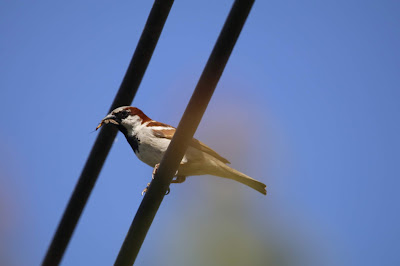This June has proven to be quite a purple patch for the local area. For a quiet month I found quite a lot of wildlife present. I know this patch so well now, I have lived in the area for five and a half years, I have certain positions I go to take photos, knowing that's where the most birds will be. The best position is towards the north of Suffolk Punch Field, where the corners of four fields meet, providing a diverse amount of habitat, viewable from one standing point.
A new sighting for the patch was a TUFTED DUCK, present on the reservoir, which didn't look quite old enough to be a breeder, but maybe one for next year. Other unusual birds included COAL TIT and GOLDCREST, unusual because of the lack of conifer plantations in the area.
As of last year PYRAMID ORCHIDS were present in an area of set aside, with around twelve spikes growing at the moment. However other plants were thin on the ground. There hasn't been a proper display of POPPIES for three years.
BROWN HARES have nested successfully in the area, in the large arable field north of the Suffolk Punch field. I had the perfect shot lined up to take of them before a naughty dog ran down the path and scared them off. On 18/6 a ROE DEER was present ploughing its way through a field of barley, with only its head showing it didn't make for a good photo.
Juvenile GOLDFINCHES lack the red on their faces like the adults have.
GOLDFINCHES have done well with several juveniles present - the birds have started to assemble into small flocks. Several pairs of GREENFINCHES are present although I haven't seen any young ones. A pair of BULLFINCHES passed through, they have bred in the past, but again I haven't seen any young birds this year.
The first fledged STARLINGS appeared towards the end of May, with the post breeding birds forming small flocks in the area. At one point a flock was constantly raided by a passing SPARROWHAWK.
There are lots of TITS present in the area as post breeding birds form flocks and move through the countryside.
This CHIFFCHAFF was present going to and fro in the area feeding demanding chicks.
YELLOWHAMMERS have started singing again probably to attract females to raise a second brood. There were four singing males in the area I was watching, with maybe as many as ten in the entire patch.
HOUSE SPARROWS are common in the area, in country houses, or in the area of Ipswich where I live.
Quite an interesting time from an area of arable fields in June, a month that seems to be the hottest in history. Already the grass looks scorched and brown and I don't know how the animals will fare going into high summer. The birds have settled down and bred successfully after the disaster of March, showing just how nature can recover if given space and time.











No comments:
Post a Comment